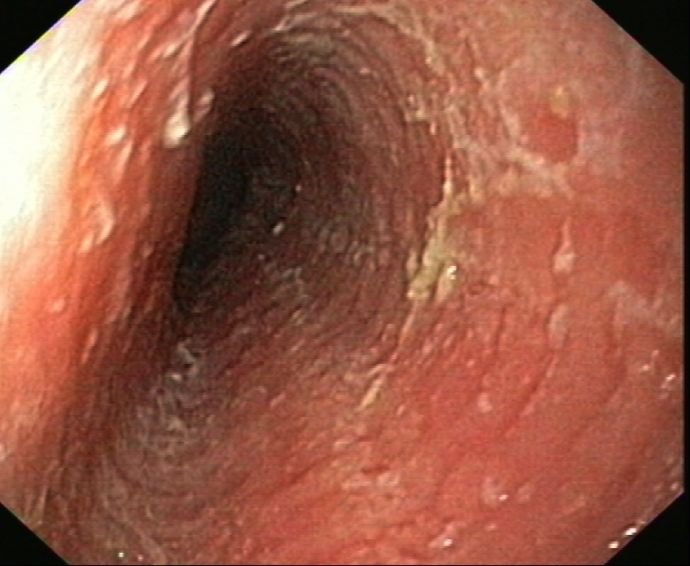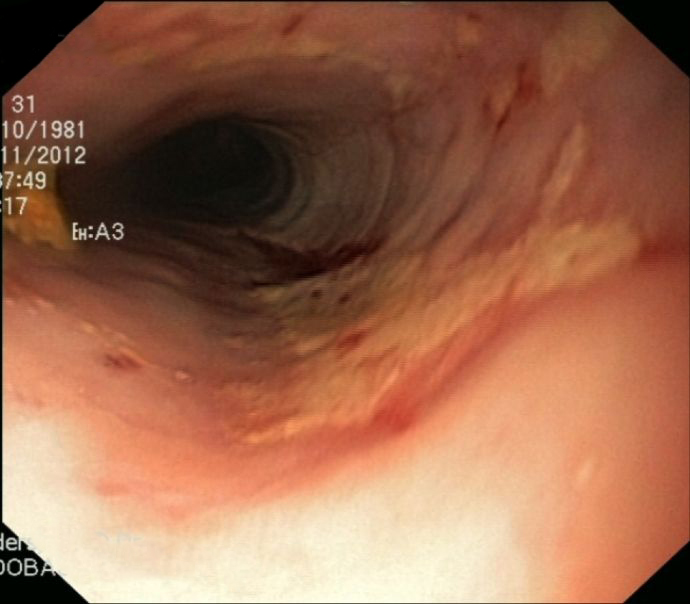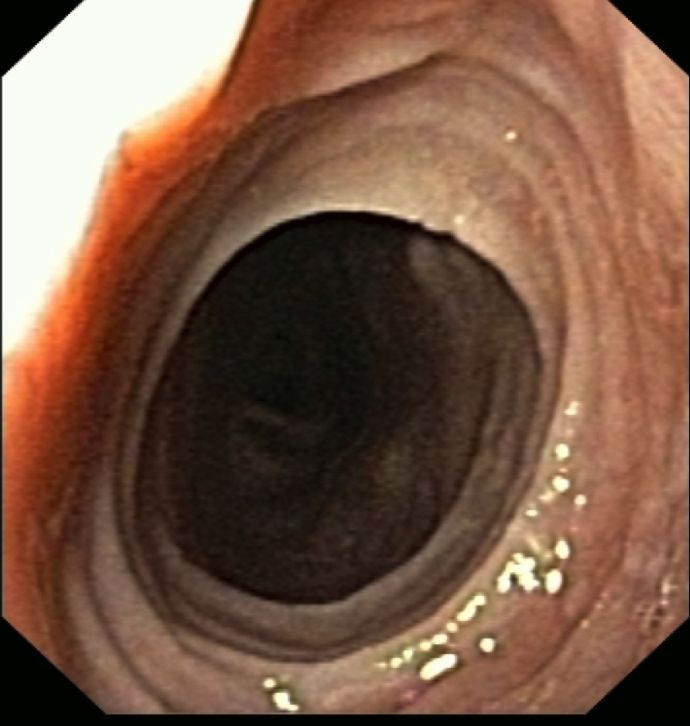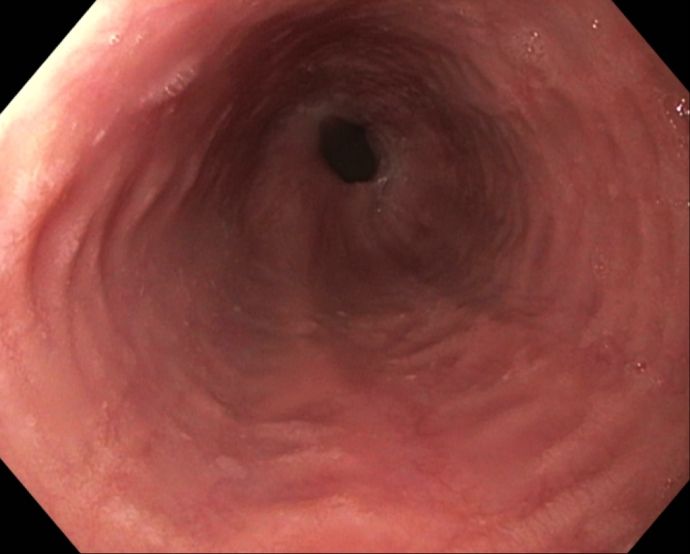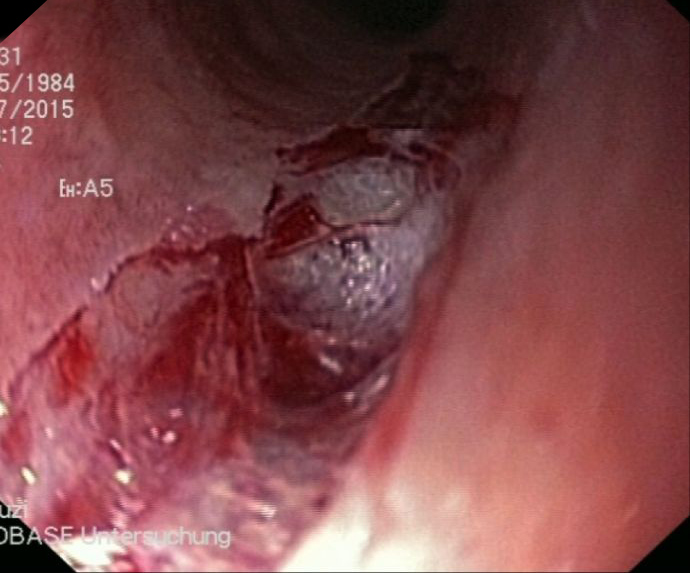Eosinophilic Esophagitis
Stephan Miehlke, Yuki Werner, and Thomas Rösch, Hamburg
A classification for eosinophilic esophagitis has not yet been included in the usual terminologies in the German-speaking countries. In the official terminology of the German Society for Digestive and Metabolic Diseases (DGVS; available on the DGVS web site or AWMF web site), for example, only the attribute “localization” is included. A group in Chicago proposed a classification in 2013 [1], which is presented here in a slightly modified form with translations [2]:
| Major features | |
|---|---|
| Fixed rings | Exsudate |
| Also reffered as concentric rings, corrugated esophagus, corrugated rings, ringed esophagus, trachealization | white spots, plaques |
| mild/moderate/severe | Yes/no |
| Furrows | Edema |
| vertical lines, longitudinal furrows | mucosal pallor, decreased vascular |
| markings | |
| Yes/no | mild/severe |
| Minor features | |
|---|---|
| Crepe-paper Ösophagus | |
| Stricture | |
| Feline esophagus* | |
| Narrow caliber esophagus |
* visible rings as in cat esophagus
Examples of eosinophilic esophagitis, 1
Hints of ring formations (mild) are visible, with whitish exudate.
Examples of eosinophilic esophagitis, 2
In these examples, the ring formations are more strongly marked (moderate), and the whitish exudate is barely visible, only distally.
Examples of eosinophilic esophagitis, 3
Without narrow-band imaging (NBI) on the left, and with NBI on the right, the ring formations have stronger and more bulging shapes (moderate ring formation, mild edema), and furrows are also visible. On endoscopic ultrasound (EUS, lower image), the mucosa in particular appears thickened and inhomogeneous. The submucosa (red arrows) and muscularis (black arrows) are well delineated and show normal thickness.
Examples of eosinophilic esophagitis, 4
With more marked exudates that are taking on the shape of flat ulcers.
Examples of eosinophilic esophagitis, 5
With marked ring formation (both images), sometimes even with perforated rings (right). Imaged with a pediatric endoscope due to the narrow space.
Examples of eosinophilic esophagitis, 6
With different grades of furrow formation; with rings on the left, in a stenosis on the right.
Examples of eosinophilic esophagitis, 7
Following a food bolus obstruction, which is frequently the reason for the patient’s presentation (left), deep mucosal defects caused by tissue vulnerability are often seen (right).
General remarks on the classifications
- The classification of eosinophilic esophagitis is primarily descriptive; there is little evidence regarding the extent to which the various grades of the individual features correlate reproducibly with the clinical course and treatment response.
- There have only been a few studies of interobserver and intraobserver variability in the classification. One study showed good correlation relative to rings, furrows, and exudates, but less good correlation for the other criteria [3], while others have reported poorer results [1,4].
Biopsy scheme: at least four biopsy samples from the distal esophagus and separately from the mid-esophagus, as well as targeted biopsies from any lesions, if present.
References
- Hirano I, Moy N, Heckman MG, Thomas CS, Gonsalves N, Achem SR. Endoscopic assessment of the oesophageal features of eosinophilic oesophagitis: validation of a novel classification and grading system. Gut. 2013;62:489-95. Epub 2012 May 22.
- Miehlke S. Clinical features of eosinophilic esophagitis. Dig Dis. 2014;32:61-7. Epub 2014 Feb 28.
- van Rhijn BD, Warners MJ, Curvers WL, van Lent AU, Bekkali NL, Takkenberg RB, Kloek JJ, Bergman JJ, Fockens P, Bredenoord AJ. Evaluating the endoscopic reference score for eosinophilic esophagitis: moderate to substantial intra- and interobserver reliability. Endoscopy. 2014;46:1049-55. Epub
2014 Sep 10. - Peery AF, Cao H, Dominik R, Shaheen NJ, Dellon ES. Variable reliability of endoscopic findings with white-light and narrow-band imaging for patients with suspected eosinophilic esophagitis. Clin Gastroenterol Hepatol. 2011;9:475-80. Epub 2011 Mar 4


